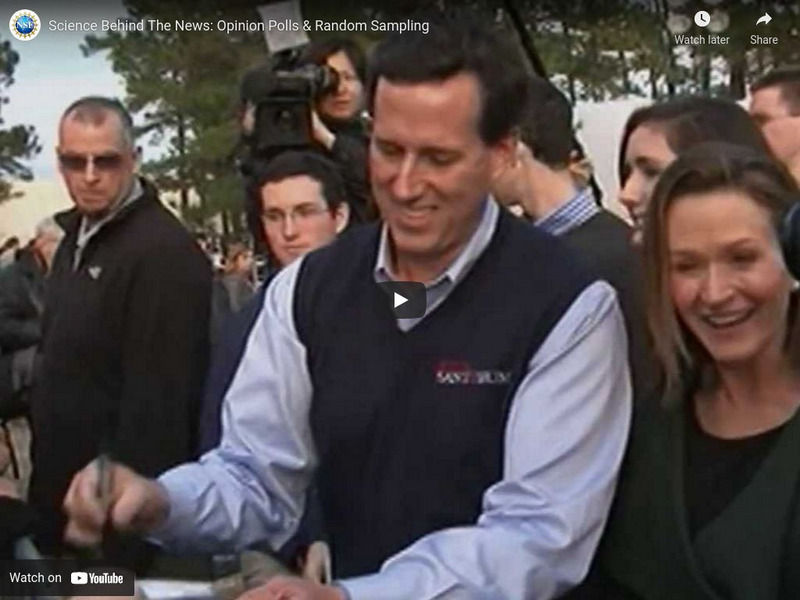Hi, what do you want to do?
National Science Foundation
National Science Foundation: Science of the Summer Olympics: Designing Safety Helmets
A mechanical engineer explains the science that goes into the design of the safety helmets used in the Summer Olympics. [5:35]
National Science Foundation
National Science Foundation: Science of the Winter Olympics: Safety Gear
Protective gear is critical to the safety of Olympic athletes. Scientists explain how safety helmets are designed to absorb the impact of a collision. [5:36]
National Science Foundation
National Science Foundation: Sustainability: Water: The Ogallala Aquifer
Scientists are studying the condition of the Ogallala aquifer underneath Kansas farmlands, which use this freshwater resource for irrigation. They want to understand changes taking place and what the future holds, and to help develop a...
National Science Foundation
National Science Foundation: Science of the Summer Olympics: Maximizing Long Jump of Bryan Clay
Bryan Clay, an Olympic decathlon athlete, worked with engineers using a stereoscopic camera system to record his movements and velocities during his long jump. They could then measure and analyze his performance immediately. [5:37]
National Science Foundation
National Science Foundation: Science of the Winter Olympics: Figuring Out Figure Skating
An Olympic skater and a scientist explain the physics behind the complex maneuvers figure skaters make, such as the triple axel and the quadruple toe loop. [5:38]
National Science Foundation
National Science Foundation: Science of the Winter Olympics: Science of Skates
The science behind the design of ice skates and their blades is explained. [5:54]
National Science Foundation
National Science Foundation: Science of the Winter Olympic Games: Building Faster and Safer Bobsleds
Scientists explain the design challenges faced when making bobsleds that are fast and safe. [6:10]
National Science Foundation
National Science Foundation: Science Ff Nfl Football: Newton's Second Law of Motion
NBC's Lester Holt and former NFL kicker Morten Andersen look at what's really behind powerful field goal kicks--Newton's Second Law of Motion. [3:51]
National Science Foundation
National Science Foundation: Science of Nfl Football: Geometric Shapes
NBC's Lester Holt explores the prolate spheroid, the three-dimensional shape of a football, and how it helps an NFL quarterback throw a hard, accurate pass. [4:09]
National Science Foundation
National Science Foundation: Science of Nfl Football: Newton's Third Law of Motion
NBC's Lester Holt breaks down Isaac Newton's Third Law of Motion and how energy transfers between football players who collide during a game. Professors Tony Schmitz of the University of Florida and Jim Gates of the University of...
National Science Foundation
National Science Foundation: Science of Nfl Football: Torque
NBC's Lester Holt describes what torque is and how the application of this force on an object causes it to spin. Professors Tony Schmitz of the University of Florida and Jim Gates of the University of Maryland explain that battles on the...
National Science Foundation
National Science Foundation: Science of Nfl Football: Kinematics
Lester Holt and former NFL running back Deuce McAllister explore kinematics on the playing field. NSF-funded scientists Tony Schmitz and John Ziegert explain how the kinematic concepts of position, velocity and acceleration can be used...
National Science Foundation
National Science Foundation: Science of Nfl Football: Newton's First Law of Motion
NBC's Lester Holt breaks down Isaac Newton's First Law of Motion and how it can change how fast players can speed the football up or slow it down. Sceince professors Tony Schmitz and Jim Gates explain why the control of inertia is so...
National Science Foundation
National Science Foundation: Profiles of Scientists and Engineers: Design Engineer
Learn what it is like to be a design engineer. Amanda Parks at MIT explains her work in designing objects that incorporate digital technology, for example, a robotic toy that records its own movements, and clothing that generates and...
National Science Foundation
National Science Foundation: Science of Nfl Football: Vectors
Learn how vectors can be used to analyze an NFL quarterback's football pass by calculating how much speed and direction are required to complete it. [3:58]
National Science Foundation
National Science Foundation: Science of Nfl Football: Nutrition, Hydration & Health
In this video, we learn about the healthy regimen that NFL players must adhere to during their gruelling pre-season training camp in order to stay hydrated and get all their essential nutrients. [5:12]
National Science Foundation
National Science Foundation: Science of Nfl Football: Projectile Motion & Parabolas
Looks at how horizontal and vertical velocity affect the parabolic path of a kicked football in this discussion of projectile motion. [4:16]
National Science Foundation
National Science Foundation: Processing Human Urine to Recycle Nutrients Into Fertilizer
This sustainable agriculture research relies on a unique contribution from humans urine. [3:48]
National Science Foundation
National Science Foundation: I Am Black History: Emilda Rivers
The National Science Foundation recognizes our very own Black History makers advancing science and impacting their communities in outstanding ways. [1:00]
National Science Foundation
National Science Foundation: Turning Co2 Emissions Into Fuel and More: Black History Today
National Science Foundation-funded engineer Etosha Cave and her team have developed technology to turn CO2 emissions into fuel. [2:02]
National Science Foundation
National Science Foundation: How Does Resolution Factor Into Computational Models?
How does resolution factor into computational models? Marsha Berger, a professor at New York University Courant Institute of Mathematical Sciences, answers the question on this edition of Ask a Scientist. [1:09]
National Science Foundation
National Science Foundation: Living Ink: Sustainable Ink Made From Algae
Living Ink Technologies is using synthetic biology to develop sustainable ink with algae. [1:40]
National Science Foundation
National Science Foundation: 3 D Wrist Bones in Motion
New, fast MRI and computed tomography scanning techniques allow researchers to study live wrist bones in motion for the first time. [1:22]
National Science Foundation
National Science Foundation: Opinion Polls & Random Sampling
During political elections, news organizations often use public opinion polls to help gauge which candidate is the front runner, and why. University of Michigan's Dr. Vincent Hutchings explains the science of random sampling that makes...










